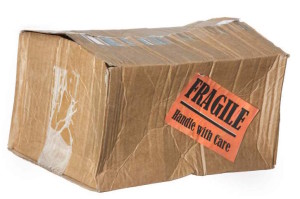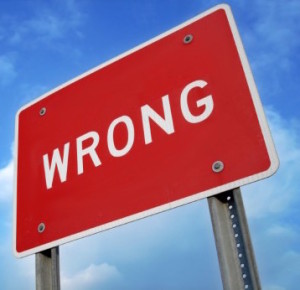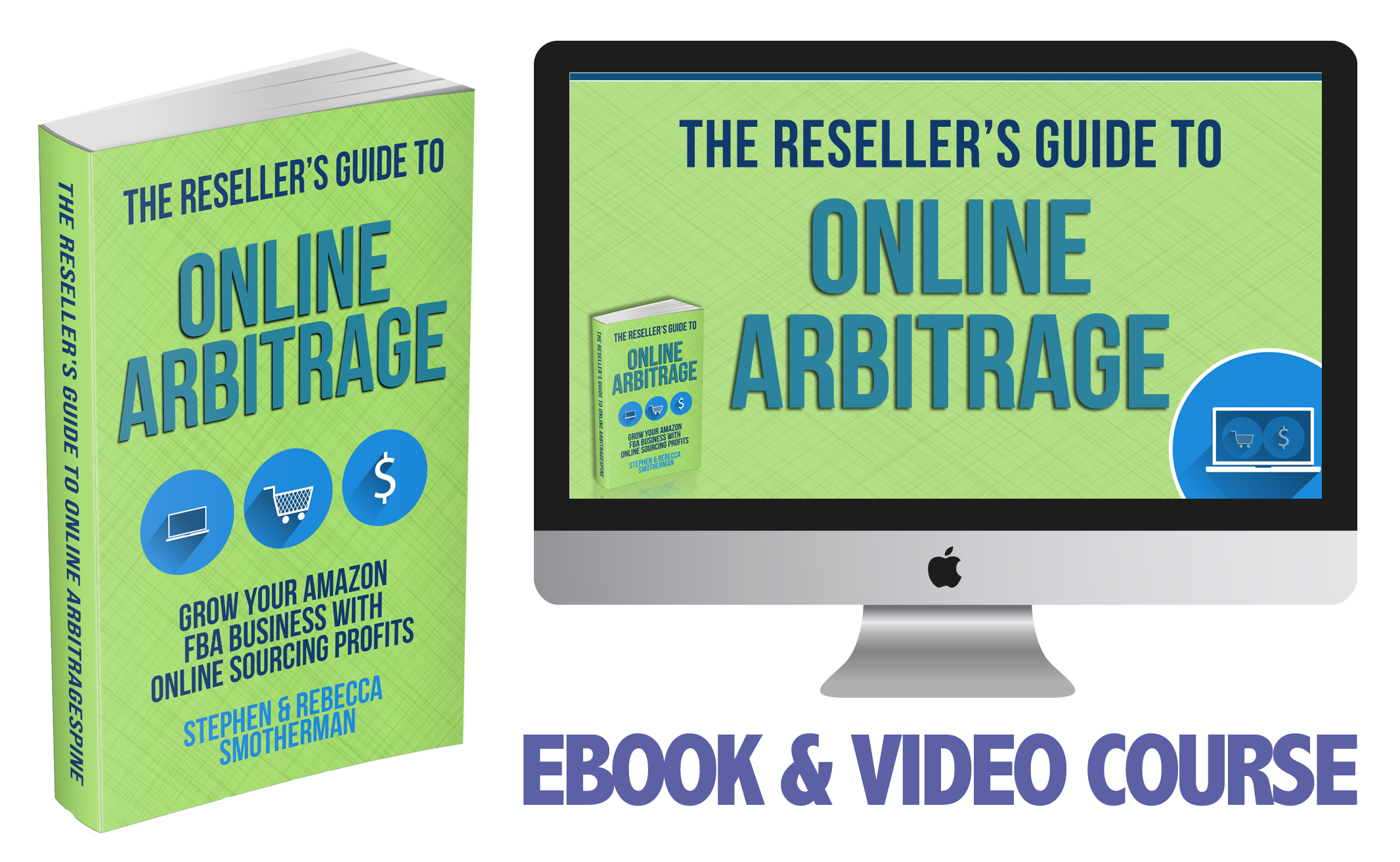By now you should know how much we love using online arbitrage (OA) as a sourcing strategy for our Amazon FBA business. Today we want to talk with you about the flip side of all the wonderful benefits we’ve seen from using OA in our business.
If we only told you that doing OA can lead to big profits for your business, but we didn’t tell you about the potential drawbacks, we wouldn’t be teaching you thoroughly. We want to keep it real. OA can be awesome, but there are also some headaches associated with it.
We have found that taking a few simple troubleshooting measures can help alleviate some of the difficulties. Rather than just listing out the drawbacks to doing OA, we want to give you strategies for dealing with the problems that can arise from OA.
 Problem #1: Receiving damaged goods
Problem #1: Receiving damaged goods
It’s super disappointing to receive an OA shipment, open the box, and find that the goods inside have been crushed or damaged during shipping. With buying shoes online, sometimes the shoes may have made it to you just fine, but the shoebox was crushed during shipment.
Solution:
First, it’s key to have a good mindset when you receive damaged OA goods. UPS isn’t perfect, nor is the person who packed the shipment perfect. Getting angry at other people isn’t a good use of mental energy. Just know that there will be times that shipments are damaged and you’ll need to return them or get a refund; it’s unavoidable.
As such, you must be responsible to know an online store’s return policy before you place an order with them. Some stores won’t do returns or exchanges on clearance items. Some stores will only do returns or exchanges if you bring the item in to a brick-and-mortar store. Some stores will only do returns or exchanges if you pay for return shipping. For our OA business, we keep a running list of stores we’ve had bad return experiences with, and we avoid shopping with them again.
 Problem #2: Receiving the wrong items
Problem #2: Receiving the wrong items
Again, the people packing your shipments aren’t perfect, and sometimes you will receive the wrong items in your OA shipment. You may receive a completely different item (like the time we ordered baseball equipment and received a hockey goal), or you may receive a slightly different item (like the times we’ve received a different edition of a board game than the one we ordered).
Solution:
Again, make sure you’re familiar with the store’s return policy and you know how to report the wrong items. Most stores are extremely apologetic and helpful when it comes to replacing or refunding wrong items received. We’ve even had some stores give us gift cards or free shipping and a discount code for future purchases as a way of making up for the trouble.
Before you rush to return or exchange a wrong item received, however, you should consider whether it’s even worth your time to deal with the problem. Can you resell the wrong item you received and at least break even? Would it be easier for you just to sell the wrong item and recoup your capital, rather than messing with a return?
 Problem #3: Time lag to send inventory to Amazon FBA
Problem #3: Time lag to send inventory to Amazon FBA
The great thing about retail arbitrage is that if you buy inventory today, you could theoretically send it to Amazon today, if you hustle to prep and ship it. With OA, it can take a few days or over a week for your purchases to reach you. By far the top complaint we hear from Amazon sellers who don’t like OA is that by the time their inventory goes live on Amazon.com, there’s more competition and the price has “tanked.”
Solution:
We don’t deny this problem of increasing competition and lowering prices on some OA inventory. But the way to overcome this problem is to make a better buying decision in the first place. Before you click “confirm my order,” double-check the Keepa price and sales rank history. Check the Keepa graph to see if Amazon is only temporarily out of stock on this item. You can’t always make a perfect decision, but if you’re making informed decisions with the help of price tracking graphs, you can lower your buying risk. Look for items that have a consistent price and sales rank history, not just ones that are temporarily inflated. You cannot make good buying decisions based on only today’s price and sales rank; you have to look at the history.
 Problem #4: I don’t know how to find good OA inventory
Problem #4: I don’t know how to find good OA inventory
The number of BOLO lists and OA services is growing every day. How do I know which ones are the best?
Solution:
We’ve covered in a previous blog post some strategies you can use to get free trials or pay for a test month of a service and collect information on whether it will work well with your business. We also covered our thought process when it comes to making a good OA buying decision. You can search in Facebook groups for Amazon FBA sellers to see if people have posted reviews of services. Sometimes, though, it just takes good old trial-and-error to find out if an OA list or service is a good fit for you. Don’t be afraid to experiment.
 Problem #5: I’m afraid an online store might ban me as a reseller
Problem #5: I’m afraid an online store might ban me as a reseller
You may hear other Amazon sellers talking about stores blocking their accounts because of their OA purchases, and you don’t want to risk it.
Solution:
We’ve been doing OA for several years now, and we have not once had an order cancelled, much less had our buying account blocked for being a reseller. We think there is one main factor contributing to our success thus far: We break up our purchases into smaller chunks. We will buy enough to get free shipping or meet a discount code requirement, but if we want to buy more, we make a separate purchase. If you spend upwards of a thousand dollars at a time, yes, there’s a big red flag for that online store.
Note: While we haven’t had OA orders cancelled due to our being resellers, we have had orders cancelled because the store suspected credit card fraud. In those instances I was able to make a quick phone call to the store and resubmit my order after verifying my identity. Having to make a phone call may seem like a hassle, but I’m thankful stores are putting that protective measure in place.
We really hope you’ve enjoyed this series of posts on online arbitrage and have found them useful. Let us know in the comments if you have any more questions that we could cover in future posts!
*Post updated for 2020![]()
FINALLY MASTER ONLINE ARBITRAGE
If you want to add or improve your existing online arbitrage (OA) sourcing skills, then check out our course: The Reseller’s Guide to Online Arbitrage: Grow Your Amazon FBA Business With Online Sourcing Profits.
The course is a combination video course (5+ hours of OA training) and a 100+ page ebook. The videos and book both share the exact same content (so you can pick the format you most like to learn from). The course also comes with six time-saving and money-making bonuses all at no additional charge!


I’ve always wondered why a retail vendor would care if we’re reselling or not? Or, sending their items to a FBA prep center address. After all, they’re making the sale on their items. Same with scanning in a retail store or, let’s say, a used bookstore. What are your thoughts?
I think some retailers are worried about other customers being upset if the retail store goes out of stock on certain items. The stores do research on how often they need to reorder from their wholesalers so they don’t do out of stock, but if resellers come in an buy more than they anticipate, then the store might have upset customers who can’t buy what they want because it’s sold out. The retail stores are not just looking at the bottom line, but at the complete customer experience. That’s why they sometimes put buying limits or ban buyers who buy out their inventory in large chunks.
The retail store I work at has metrics for performance for each month. One of the biggest weighted items is out of stock. If a customer complains that we were out of stock, it skews our metrics for that month and the manager gets talked to and the store gets put on the bad list. This goes even if it is an item that was seasonal and was clearanced. One of the many reasons I want to do my own FBA business and not work retail anymore.
That’s very interesting. Thanks for sharing!
This is very interesting. In your opinion would it be better to talk with the store manager to see if they can order the items so that out of stock is not an issue.
That’s possibly a good solution if the store manager trusts that you’ll be back to buy what you promise to buy. .
I always wondered that myself. I think it comes down to a “scarcity” mindset, sometimes. What if those aggressive resellers buy up all the “good stuff” in the store?
I agree with you, though. If the retailer set their price, and wants to sell at that price, it seems to me they’d be delighted that some of us want to buy up all of their items at that price and clear them some shelf space for other things.
I do understand a retailer not wanting resellers to buy “loss leaders” in large quantities, the sale items that are supposed to entice other shoppers into the store, where they will hopefully find other, regular priced items to buy. I personally try to be more conservative in large purchases of loss leaders, but have no compunctions about clearance or used items.
This is why Best Buy puts quantity limits on certain sale price items. Those sale priced items are used to draw buyers into the store in the hopes they’ll buy something else.
Nice points, thanks! I hope to expand my OA so this is very helpful.
When doing OA through FBA, will Amazon adjust their buy price that they pay me for the inventory as items are sold, or does the price they pay me stay the same and Amazon takes the risk of prices going down?
So… if I send Amazon 100 units of a widget, is the Amazon “buy price” locked regardless of what they sell the item for?
When it comes to physical products you are selling (retail or online arbitrage), Amazon doesn’t control your price… You pick the price you want to sell the item at and then the customer decides if they want to pay your price. After the customer buys, Amazon takes out their % fees and you get the rest put into your next disbursement.
That’s not entirely true. Amazon’s Fair Pricing Policy has been limiting pricing on items even when other sellers have a higher selling price. An Amazon Customer Service Rep told me that Amazon looks at your prior selling history of that item and determines what price they will allow you to sell it at. If you don’t have a selling history for that item you could run into trouble by assuming you can sell it for what other sellers are pricing it at.
Stephen,
I’m shocked that you managed to avoid the Target reseller bans last year. Did you not have tax exempt set up on your Target.com account?
We choose to pay sales tax at Target and see it as a cost of doing business there. We make sure we still buy items there that will be profitable even after paying sales tax.
Another great article Stephen! I think too often that OA gets a bad rap. However, if done properly (like you outline in your articles), it’s a great way to source products for people that have time constraints (like me). Thanks buddy!
Jay
Question about shoes – Do you buy shoes that come with the box cover or will you buy shoes that have the covers ripped off and polybag the shoes with the box?
Thanks!
We do not send shoe boxes w/o the covers. We always send the shoes to Amazon with the entire shoe box (as required my Amazon rules). The only exception is if the shoes don’t originally come in a box (like some brands of flip flops, crocs, sandals, etc.) then we’ll poly bag them with very strong bags.
I thought the new rule was shoes had to have the original box- did I misunderstand the always so ‘easily understood’ Amazon rules?
Yes, the new rule is that all shoes need their original shoe box, but some shoes (like crocs, flip flips, etc) don’t come in boxes and only come in bags. In those cases, we’ll use polybags – but MOST shoes come with a shoebox and need the shoebox to sell on Amazon.
Great article, as always, Stephen! How do you handle expiration dates with online orders. Some replens I sell are no problem, but others have arrived with expiration dates too close to send in. AND, some of these items can’t be returned to store, they won’t accept returns on certain items. So, for these, I have tried to get into the store and check for myself. But, this strategy has been decimated by all the shutdowns.
We have found that sourcing items with expirations dates via OA is really hit or miss, so we don’t do that anymore. If you find a place that always sends out items with a good lead time in regards to expiration dates, then definitely stick with them as they are harder to find.
Thanks Stephen, great points.
Hi nice article. I appreciate this is USA but I’m in UK.
I get buying large quantities of an item would trigger reseller detections but you state you buy lower quantities and then more in a separate purchase. Is that subsequent order straight away or is there a time between the two?
For example I bought (and sold out) 10 of a fast selling item about 4 weeks ago and want to buy more but am worried they may see this as restocking.
Thanks.
I’d purchase a lower number of items and then order more after I get the shipping notification from the first order. Buying more of an item should not be an issue unless the first order has not shipped yet.